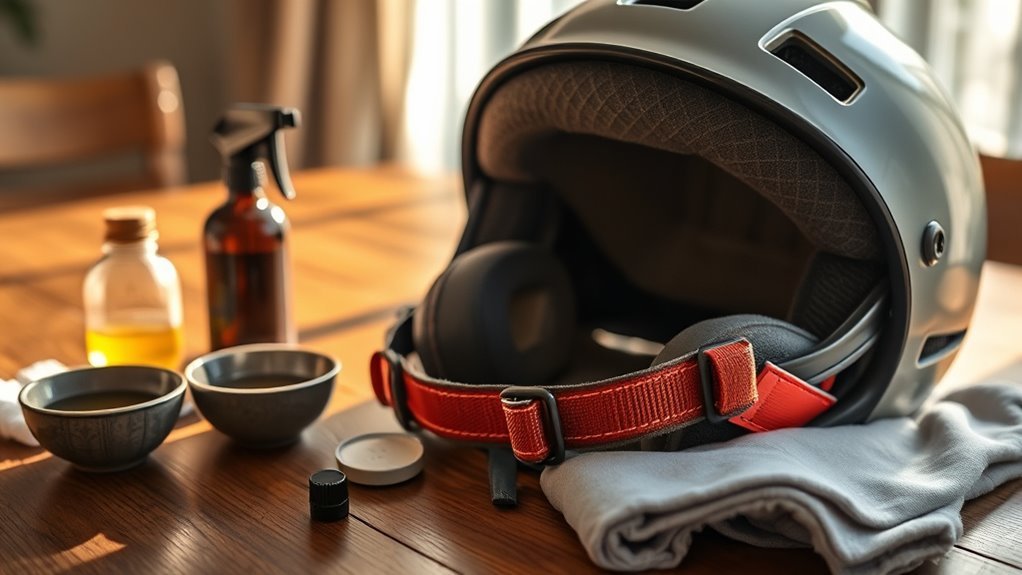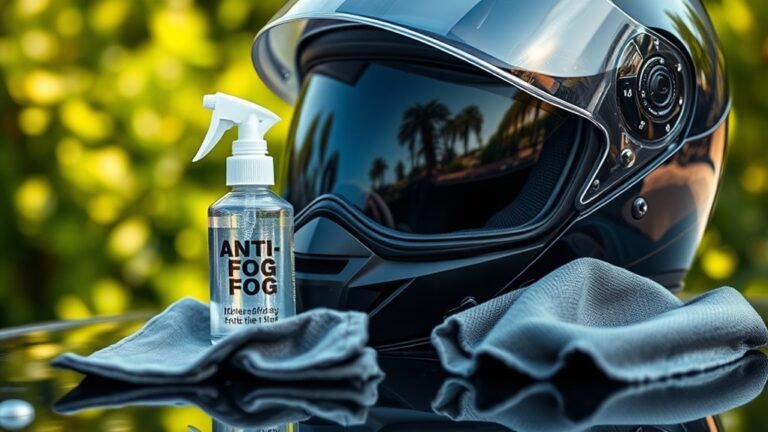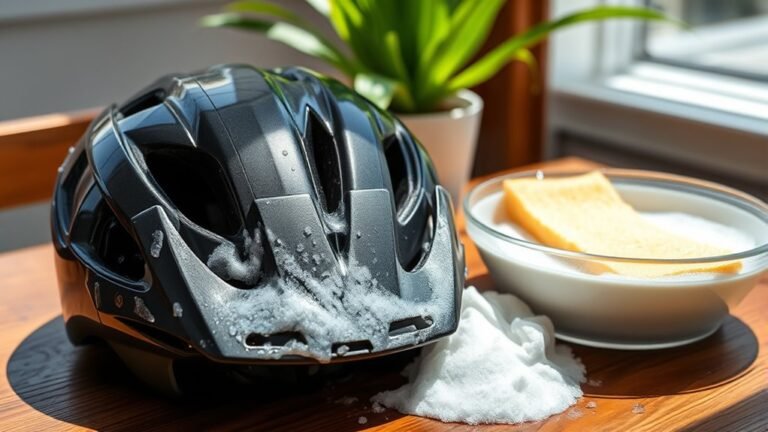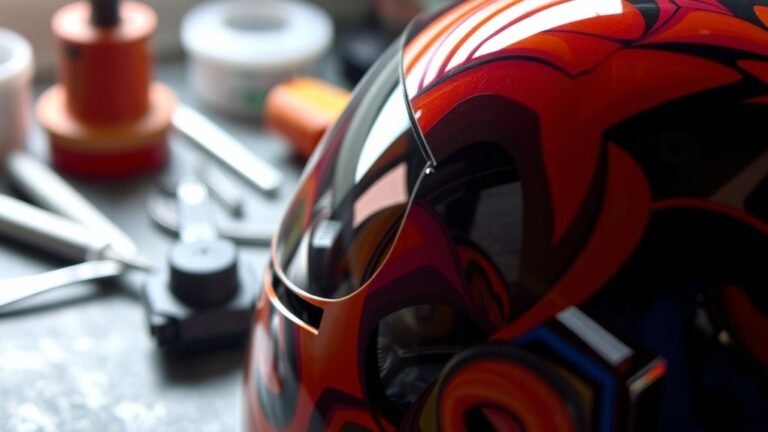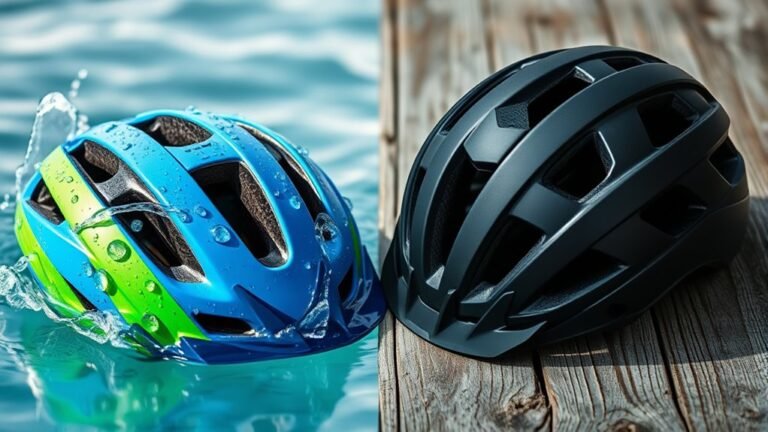How to Maintain Helmet Straps for Durability
To maintain helmet straps for durability, inspect them regularly for signs of wear, such as fraying or discoloration. Clean straps gently using mild, non-abrasive cleaners, and air dry them away from sunlight. Adjust straps for a secure fit, ensuring they’re snug but comfortable. Store your helmet in a cool, dry place to prevent damage. Always choose high-quality materials like nylon or polyester for replacements. Stick around to discover tips on avoiding common maintenance pitfalls.
Inspecting Helmet Straps Regularly
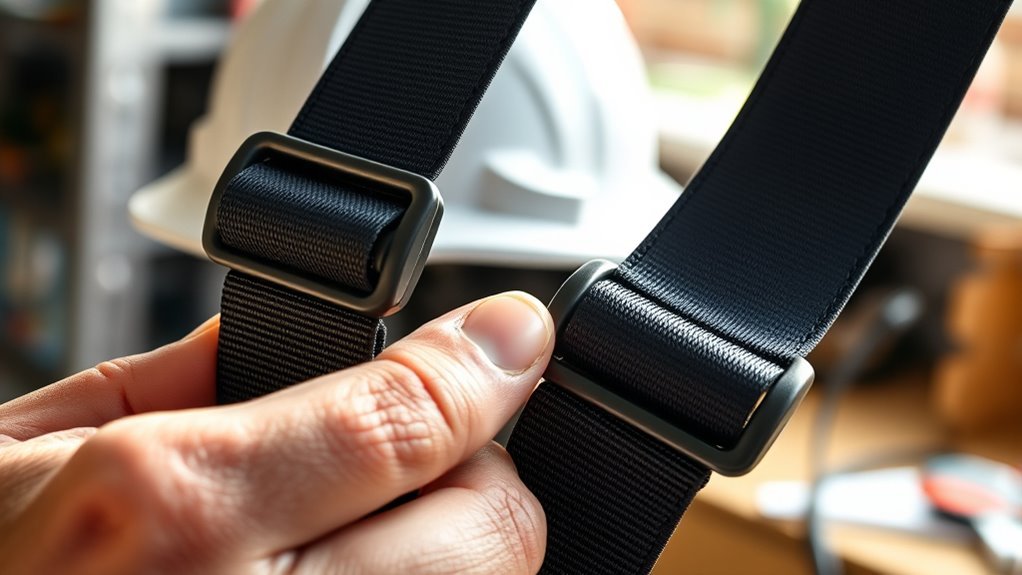
To guarantee your safety while riding, it’s important to inspect helmet straps regularly. Start by examining the strap materials for any signs of wear, fraying, or damage. High-quality materials like nylon or polyester are common, but even the best can degrade over time. Next, check strap adjustments to confirm they fit snugly against your chin and cheeks. An improper fit can compromise protection, so make sure the straps are neither too loose nor too tight. Don’t forget to verify the buckle mechanism’s functionality, as it’s vital for quick release in emergencies. By maintaining vigilance over these aspects, you’ll enhance your helmet’s effectiveness, allowing you to enjoy the freedom of the ride with confidence.
Cleaning Techniques for Helmet Straps
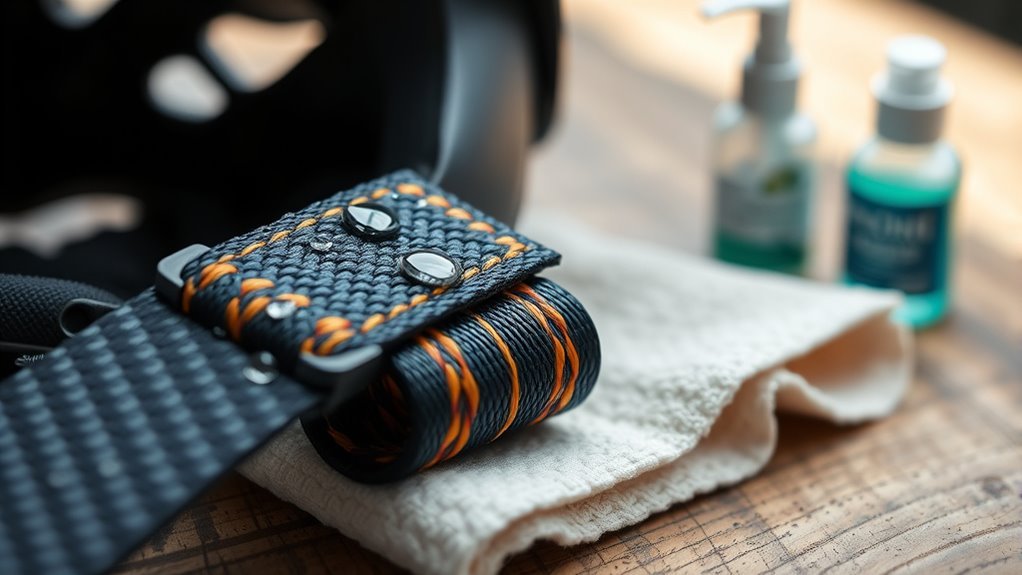
To keep your helmet straps in ideal condition, establishing a regular washing routine is essential. You’ll want to know effective stain removal methods to tackle any dirt or grime that accumulates over time. Finally, proper drying and storage techniques will help maintain the integrity and longevity of your helmet straps.
Regular Washing Routine
While helmet straps may seem like a minor aspect of your gear, keeping them clean is vital for both hygiene and safety. Establishing a regular washing routine can enhance their durability and performance. Aim to wash your helmet straps every few weeks, or more frequently if you ride in humid or dusty conditions. For detergent selection, opt for a mild, non-abrasive cleaner that won’t degrade the strap materials. Avoid bleach or harsh chemicals, as they can compromise the integrity of the straps. Hand washing is often best; gently scrub the straps with a soft brush and rinse thoroughly. Proper drying is essential—let them air dry away from direct sunlight to prevent material degradation. Regular maintenance guarantees your helmet remains safe and comfortable.
Stain Removal Methods
Even with a regular washing routine, helmet straps can accumulate stubborn stains from sweat, dirt, or environmental factors. To effectively tackle these stain types, you’ll need the right cleaning solutions. Here are three methods to evaluate:
- Vinegar Solution: Mix equal parts white vinegar and water. Soak a cloth in the solution and gently scrub the strap to lift tough stains.
- Baking Soda Paste: Combine baking soda with water to form a paste. Apply it to the stain, let it sit for about 15 minutes, then rinse with warm water.
- Commercial Stain Remover: Use a stain remover specifically designed for fabric, following the manufacturer’s instructions for effective results.
Drying and Storage Tips
After you’ve cleaned your helmet straps, proper drying and storage are essential to maintain their integrity and extend their lifespan. Use air drying as your primary drying method; avoid direct sunlight, which can weaken the material. Lay the straps flat on a clean towel, allowing air circulation for effective drying. For storage solutions, consider a breathable bag or a hook where straps can hang freely without creasing.
| Drying Methods | Storage Solutions |
|---|---|
| Air Drying | Breathable Bag |
| Avoid Direct Sunlight | Hanging Hooks |
| Flat on Towel | Cool, Dry Place |
Following these tips guarantees your helmet straps remain resilient, giving you the freedom to ride without worry.
Checking for Wear and Tear
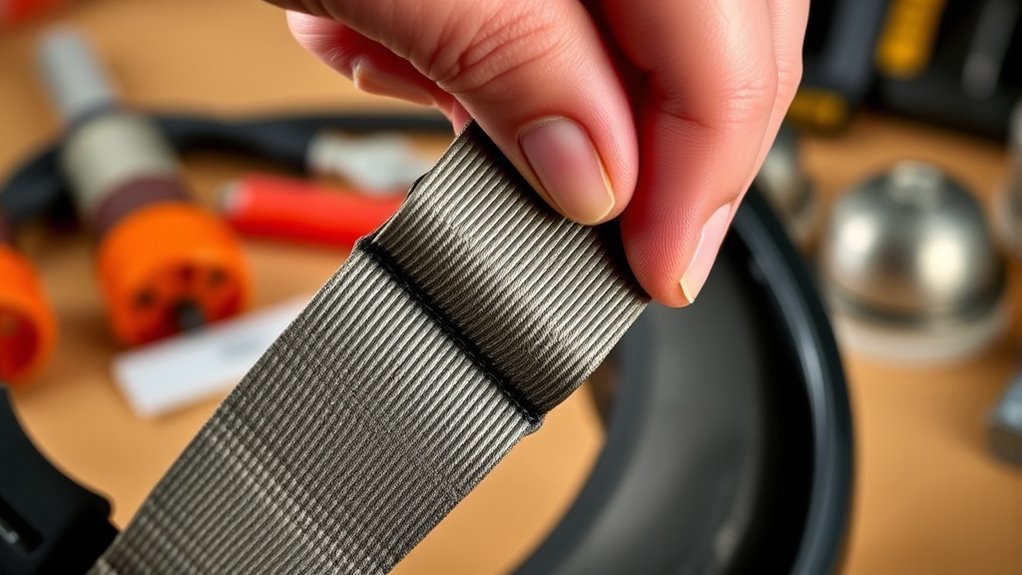
Helmet straps are imperative for guaranteeing safety during any activity that requires head protection, making it essential to regularly check them for wear and tear. To maintain the integrity of your helmet straps, look for the following:
- Wear Indicators: Check for any signs of fraying or discoloration, which can indicate that the strap materials are degrading.
- Material Integrity: Assess the straps for stiffness or brittleness. Flexible materials are essential for proper function.
- Buckle Functionality: Verify that the buckles are secure and operate smoothly. Any difficulty in fastening can compromise safety.
Proper Storage of Your Helmet
To guarantee your helmet remains in peak condition, store it in a cool place away from direct sunlight. UV rays and heat can degrade materials over time, compromising safety. Using a helmet bag can provide additional protection against dust and physical damage.
Store in a Cool Place
When you’re not using your helmet, it’s important to store it in a cool place to prevent damage from excessive heat. Proper temperature control and humidity management can greatly extend your helmet’s lifespan and maintain strap integrity. Here are three tips for effective storage:
- Choose a dry, ventilated area – Avoid damp environments that can promote mold growth and strap degradation.
- Keep away from heat sources – Don’t place your helmet near radiators, stoves, or direct sunlight, which can warp materials.
- Use a helmet bag – A protective bag can reduce exposure to temperature fluctuations and assist in maintaining consistent humidity levels.
Avoid Direct Sunlight
Exposing your helmet to direct sunlight can substantially compromise its structural integrity and material longevity. Continuous sunlight exposure leads to UV damage, which breaks down the materials, particularly plastics and foams used in helmet construction. This degradation not only weakens the straps but also reduces the overall effectiveness of the helmet in protecting you during rides. To maximize durability, always store your helmet in shaded areas or indoors where sunlight can’t reach it. If you’re traveling, think about using a car’s trunk or a covered space to guarantee it’s shielded from the sun. By avoiding direct sunlight, you maintain the safety features of your helmet and prolong the life of its straps, ensuring you stay protected on your adventures.
Use Helmet Bags
Storing your helmet properly is just as important as protecting it from sunlight. A good helmet bag not only shields your gear but also enhances durability. Here are some helmet bag benefits:
- Protection: Helmet bags safeguard against dust, scratches, and impacts, ensuring your helmet stays in top shape.
- Material Variety: Available in various materials like nylon, polyester, and leather, these bags cater to different preferences and needs for durability.
- Convenience: Most helmet bags come with adjustable straps and compartments, making transportation easy and organized.
Investing in a quality helmet bag is essential for maintaining your helmet’s longevity. With the right bag, you’re not just storing your helmet; you’re preserving your freedom to ride confidently.
Adjusting Straps for a Secure Fit
To guarantee ideal safety and comfort while wearing a helmet, you must adjust the straps for a secure fit. Begin by ensuring the strap tension is firm but not overly tight, allowing for movement without compromising security. The side straps should form a V-shape just below your ears, while the chin strap should rest snugly under your chin. Make secure adjustments by sliding the strap ends through the buckles, ensuring they lock in place. Always double-check that the helmet sits level on your head and doesn’t shift when you move. A properly fitting helmet enhances your freedom of movement while providing maximum protection, so take the time to get those adjustments right. Your safety depends on it.
Replacing Damaged Straps
When it comes to maintaining helmet safety, identifying wear and tear on your straps is essential. If you notice fraying, cracking, or any signs of damage, it’s time to evaluate replacement options. Choosing the right replacement straps guarantees your helmet continues to provide peak protection.
Identifying Wear and Tear
Although helmet straps are designed for durability, regular inspection is essential for ensuring safety. Identifying wear and tear helps you maintain your helmet’s integrity. Here are some common damage signs to look for:
- Fraying: Check the straps material for any signs of fraying. This can weaken the strap and reduce its effectiveness.
- Cracks or Breaks: Inspect for cracks or breaks in the buckles or adjusters. These components are vital for secure fastening.
- Fading or Discoloration: Sun exposure can degrade straps material over time. If you notice significant fading, it’s time to reflect on replacement.
Choosing Replacement Options
Once you’ve identified wear and tear on your helmet straps, it’s important to evaluate replacement options to maintain safety and performance. Start by considering the strap materials; durable nylon or polyester are popular for their strength and resistance to environmental factors. Look for straps that offer both comfort and reliability. When selecting replacement brands, verify they meet industry standards for safety and performance. Brands like Bell, Giro, and Smith provide high-quality options tailored to various helmet types. Additionally, check compatibility with your helmet model; mismatched straps can compromise safety. By investing in the right materials and brands, you’ll guarantee your helmet straps continue to provide the support and security you need for your adventures.
Choosing Quality Helmet Straps
Choosing quality helmet straps is essential for guaranteeing your safety and comfort while wearing a helmet. When selecting straps, consider these critical factors:
- Strap Materials: Opt for high-quality materials like nylon or polyester, as they offer flexibility and strength.
- Strap Durability: Look for straps that are reinforced or have UV resistance to withstand wear and environmental elements.
- Adjustability: Ascertain the straps have adjustable features to provide a secure fit, enhancing both comfort and safety.
Avoiding Common Mistakes
When maintaining helmet straps, it’s crucial to avoid common mistakes that can compromise both safety and comfort. One frequent error is neglecting to check for wear and tear. Regularly inspect the straps for frays or weak points; these common strap issues can lead to failures during use. Additionally, improper adjustments can hinder the fit, so always verify straps are snug yet comfortable. Follow strap maintenance tips like cleaning with mild soap and air drying, as harsh chemicals can degrade materials. Finally, don’t forget to replace straps when they show signs of significant wear. By steering clear of these pitfalls, you’ll enhance your helmet’s effectiveness and extend its lifespan, allowing for a safer, more enjoyable ride.
Using Helmet Accessories Wisely
Although helmet accessories can enhance safety and comfort, using them wisely is essential to avoid compromising your protection. Here are some guidelines to help you make the most of your helmet accessories:
- Choose Quality Helmet Covers: Verify your helmet cover fits snugly and is made from durable materials. A well-fitted cover protects against weather elements and enhances visibility.
- Use Strap Pads Wisely: Invest in strap pads for added comfort. Make sure they’re designed for your helmet type, as ill-fitting pads can interfere with the strap’s effectiveness.
- Regularly Inspect Accessories: Regularly check your helmet covers and strap pads for wear and tear. Replace any damaged items promptly to maintain maximum safety and comfort.
Maintaining Straps in Extreme Conditions
Maintaining helmet straps in extreme conditions is essential, as harsh environments can greatly affect their integrity and performance. When engaging in rugged activities, you’ll want to inspect your straps regularly for signs of wear and tear. In extreme weather, such as intense heat or freezing temperatures, materials can degrade quickly. Clean straps with mild soap and water to remove dirt, and let them dry completely before storage. If you notice fraying or weakened areas, replace the straps immediately. Consider using UV-resistant or waterproof straps to enhance durability. Finally, store your helmet in a cool, dry place when not in use, as prolonged exposure to extreme conditions can compromise their strength. With proper care, you can guarantee the longevity of your helmet straps.
Frequently Asked Questions
Can Different Helmet Brands Use Interchangeable Straps?
Different helmet brands typically don’t offer interchangeable compatibility for straps due to unique brand specifications. Each brand designs straps tailored to their specific helmets, guaranteeing peak fit and safety. While some generic options might fit, it’s essential you check compatibility carefully to maintain performance and comfort. Using non-compatible straps can compromise safety features, so stick with the manufacturer’s recommendations to make sure your helmet functions as intended while enjoying your freedom on the road or trail.
What Materials Are Best for Helmet Straps?
For helmet straps, nylon offers superior durability, making it ideal for high-impact activities, while polyester provides enhanced comfort against your skin. Nylon’s resistance to wear and tear guarantees your straps last longer, essential for those seeking freedom in action sports. On the other hand, polyester’s softness minimizes chafing, allowing for extended use without discomfort. Choosing a combination of both materials can give you the best of durability and comfort during your adventures.
How Often Should I Replace My Helmet Straps?
You should replace your helmet straps every two to three years, but if you notice any signs of wear—like fraying, discoloration, or stiffness—it’s time for a change, no matter the strap lifespan. These indicators can compromise your safety, and you wouldn’t want to risk your freedom just for a few extra rides. Regular inspections and timely replacements guarantee your helmet remains secure and effective, keeping you protected on every adventure.
Can I Customize My Helmet Straps?
Yes, you can customize your helmet straps! Many manufacturers offer options for strap designs and strap colors, allowing you to express your style while maintaining functionality. When customizing, verify the materials are durable and suitable for your specific activities. This way, you not only enhance your helmet’s appearance but also guarantee that it remains safe and secure. Remember, a personalized touch can make your gear feel more unique and aligned with your freedom-loving spirit!
Do Helmet Straps Need Special Care in Winter?
Yes, helmet straps need special care in winter. Picture snowflakes drifting down, coating your helmet. To guarantee peak performance, you should check for moisture and ice that can freeze the straps, compromising their integrity. Consider adding strap insulation or using a protective cover to keep them warm and flexible. Regularly clean the straps, removing any salt or debris from your winter adventures, to maintain their durability and keep your rides safe and enjoyable.
